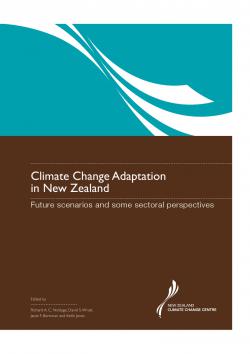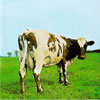 How will our land-based primary industries manage the climate changes ahead? That’s the question addressed by chapter 3 in Climate Change Adaptation in New Zealand (pdf download here). The general impression given is that they won’t fare too badly provided appropriate adaptive measures are taken. The chapter, contributed by a team of nine, reports on modelling examples from the three major areas of forestry, arable farming and pastoral farming. It’s apparent that there is a level of complexity to farming operations which is very difficult to embrace in any study and the writers make it clear that much ongoing research will need to be undertaken. I’ll pick out a few salient points from the paper.
How will our land-based primary industries manage the climate changes ahead? That’s the question addressed by chapter 3 in Climate Change Adaptation in New Zealand (pdf download here). The general impression given is that they won’t fare too badly provided appropriate adaptive measures are taken. The chapter, contributed by a team of nine, reports on modelling examples from the three major areas of forestry, arable farming and pastoral farming. It’s apparent that there is a level of complexity to farming operations which is very difficult to embrace in any study and the writers make it clear that much ongoing research will need to be undertaken. I’ll pick out a few salient points from the paper.
So far as forestry is concerned productivity is likely to be affected by changed CO2 levels, rainfall and temperature. Fire danger will increase in most areas of New Zealand. Increased severe winds are also predicted in some parts of the country. Pests and fungal diseases are likely to be strongly affected and the impacts of weeds and fungal pathogens could change, as could the establishment and distribution of insect pests.
The forestry modelling reported was focused on two common fungal diseases which affect forest productivity. One of the two diseases responds positively to aerial applications of copper oxychloride, and there may need to be changes to the way these are made as risk areas are identified. Other adaptation options for both diseases might include developing disease resistant genotypes, changing the regimes to modify the within forest microclimate (especially air movement and humidity), changing the tree species totally on at risk sites, and possibly moving the forests to less risky sites as the climate changes.
Adaptation strategies in general will involve normal forest practices and, provided a good understanding of the changes needed is obtained, the study concludes we should be able to maintain the health and productivity of our forests.
Arable farming is likely to benefit from climate change, provided nutrients and water supply are not limited. (That struck me as a big proviso.) The advantages result from a number of factors. One is the fertilising effect of increased CO2 . Another is the rise in temperature causing crops to grow faster, be harvested earlier, and leave more options for subsequent crops. A warmer drier spring means soil dry enough for earlier cultivation and sowing operations. An extended frost free period enables frost-sensitive crops to extend their range. And so on. A model run of one crop showed a 16% increase in yield by 2090 under the high carbon scenario and a 3 week earlier harvest.
But the water and nutrient caveat is important, particularly as most cropping occurs on the east coast, which is expected to see more hot, dry weather. Irrigation systems will need to be efficient, and crops with a deeper root system may fare better. For although climate change increases yield potential and management flexibility in systems that have good water availability, it does the opposite for dryland systems and those with limited irrigation. The paper notes that there remains significant uncertainty around the impacts of climate change on water flows in the major alpine rivers which underpin the east coast irrigation water supply.
Pastoral farming, the biggest contributor to New Zealand’s agricultural exports, was approached through modelling a Manawatu dairy farm. It was modelled on a single mid-range climate change scenario. Two soil types were modelled, clay and sand. Pasture production increases, especially between 2000 and 2030, were predicted, particularly in late winter, spring and summer. Potentially this is due to increased temperatures and solar radiation and increased prevalence of C4 (warm season) grasses. But the C4 grasses led to a reduction in pasture quality during summer and spring.
Unadapted systems resulted in a decline in milk solids production per cow and per hectare in both 2030 and 2080, compared with 2000. The picture changed when adaptation measures were undertaken. Key adaptation measures included a range of farm management decisions which included earlier calving and increased stocking rates. With such measures the paper reported adaptation can be profitable and turn the potential negative of lower pasture quality into the positive of more production. However the writers acknowledge that they did not consider the impacts of the recommended adaptations on significant environmental issues. More cows may increase nutrient and greenhouse gas losses from the farm.
It was such consequences that left me wondering how robust some of the adaptation measures may prove to be. Currently more cows mean more methane. Adaptation measures which also increase greenhouse gas emissions will surely be looked at askance by 2030. And the prospect of more nutrient run-off is fraught with environmental consequences. For arable farming the irrigation issue carries many questions likely to prove difficult of resolution. However there will no doubt be closer examination of these and other adaptation possibilities as time proceeds. Presumably Federated Farmers will eventually emerge from its bunker and share in the process. The paper speaks of farm producers in New Zealand as innovative and adaptable and able to live with climate variability. But it points to climate change as more than variability when it goes on to ask whether those producers will be adaptable enough to manage a changing as well as variable climate. In the current mind-set of denial displayed by much of the farming community that seems to me an open question.
Like this:
Like Loading...
 This, from Don Nicolson, president of Federated Farmers, appropriately titled In denial over denial, slipped under the radar last week while I was watching the ACT car crash.
This, from Don Nicolson, president of Federated Farmers, appropriately titled In denial over denial, slipped under the radar last week while I was watching the ACT car crash.
 You may have noticed that New Zealand’s
You may have noticed that New Zealand’s  How will our land-based primary industries manage the climate changes ahead? That’s the question addressed by chapter 3 in Climate Change Adaptation in New Zealand (pdf download
How will our land-based primary industries manage the climate changes ahead? That’s the question addressed by chapter 3 in Climate Change Adaptation in New Zealand (pdf download  Tomorrow morning, a large chunk of New Zealand’s much debated Emissions Trading Scheme comes into effect. Forestry’s already been in it for two years, but July 1st is the day that the liquid fuels and electricity generation sectors start to have to account for their emissions, and it’s the first day that consumers might see a change in fuel and electricity prices that can be blamed on the ETS. Last week’s National Business Review had a pretty good overview of the state of play
Tomorrow morning, a large chunk of New Zealand’s much debated Emissions Trading Scheme comes into effect. Forestry’s already been in it for two years, but July 1st is the day that the liquid fuels and electricity generation sectors start to have to account for their emissions, and it’s the first day that consumers might see a change in fuel and electricity prices that can be blamed on the ETS. Last week’s National Business Review had a pretty good overview of the state of play